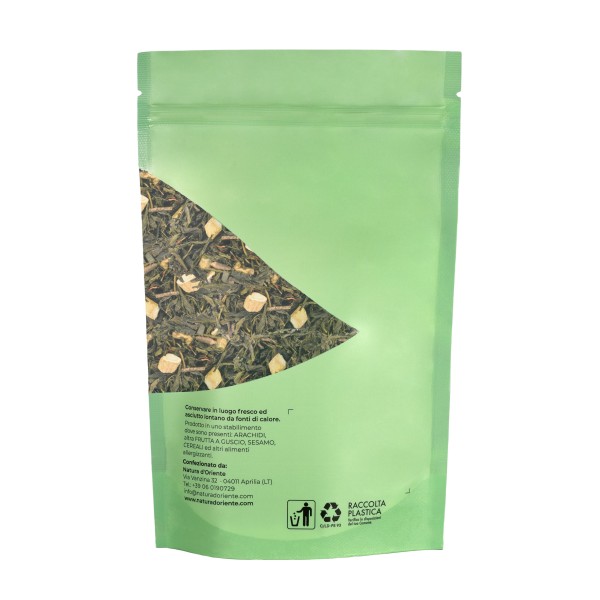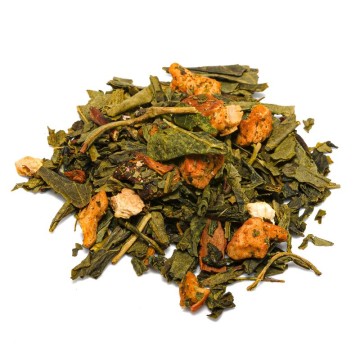Green tea and red ginseng and lemon
Both green tea and ginseng have similar benefits on the well-being of our body, which is why the combination of the two ingredients is highly appreciated. Among the most interesting features, there are the properties that green tea with ginseng can offer to the well-being of the organism. Furthermore, thanks to the presence of lemon peels, the flavor and aroma of this tea are sweet and refreshing.
Properties and benefits
The combination of ingredients can give valuable help to the immune system. In fact, ginseng is used in alternative medicine as a booster for the immune system, and helps prevent cold and flu symptoms. The enrichment with lemon peel also gives a dose of vitamin C. For cardiovascular well-being, ginseng and green tea are both generally traditionally linked to support of cardiac and circulatory function.
Adding ginseng to green tea supports heart health, systolic blood pressure and blood flow regulation. Green tea is a food that works to prevent hardening of the arteries, and promotes the reduction of total cholesterol and LDL cholesterol. At the same time, it supports the increase in HDL cholesterol levels known as "good cholesterol". The combination of green tea and ginseng could help control fluctuations in blood glucose levels, although there are still studies on this topic.
A gift that is probably greatly appreciated by the combination of tea green and ginseng, is the one that stimulates the metabolism through the content of caffeine (theine) and catechins. These ingredients may aid in weight loss, along with the properties of ginseng – designed to reduce internal fat deposits. Ginseng is an "adaptogenic" remedy that adapts to the body according to its needs and the particular situation in which it finds itself. For this reason, it can accumulate fats when they serve to protect against the cold, while it can promote the consumption of fats when they are in excess in the body. Traditionally, ginseng was used in Chinese medicine to combat states of weakness, tiredness and stress.
Also to increase and improve physical performance. Furthermore, the purifying effects of the tea are supported by the lemon component, which helps the detoxification factor. The antioxidant polyphenols of green tea can join the properties of red ginseng, enhancing the anti-aging properties. Furthermore, green tea contains compounds with natural antibacterial properties, which go well with lemon.
Origins and History of cultivation
Green tea has been part of Japanese culture for centuries, despite having a Chinese origin. The Chinese have known about tea leaves for thousands of years (about 2700 BC), and they were mentioned in the first book ever written on cultivation and beverage: The Classic of Tea, written by Lu Yu (8th century) during the Tang Dynasty. In his writings Lu Yu also describes the health benefits of green tea known at the time. At the time, the processing was done with pressed dry leaves, and in Japan it was very successful. Many Japanese Buddhist monks traveled to China to further their religious knowledge, later founding their own schools in Japan.
It was at the beginning of the Heian period (794-1185) that they also brought tea seeds from China, and gradually it became an upper-class drink. Its cultivation spread, and the healing properties of green tea were explored, also used in religious ceremonies. Ground matcha green tea was initially used, but soon the processing of dried green tea became more widespread. A turning point in processing occurred in 1738, when the new method of Sencha was developed, the most popular green tea in Japan. The history of ginseng is very old, having been known for millennia. The Panax ginseng plant was discovered about 5,000 years ago in the mountains of Manchuria, China. It is native to the mountainous regions of the Far East, between Russia, northeastern China and Korea. Today it is also grown in some areas of Japan.
Originally it was used as a food, and its properties spread especially in China. It was a highly prized root for emperors, and some historical evidence indicates that ginseng was used by royalty before the Han Dynasty (c. 200 BC). It was revered for its power to bring health, virility, and long life, and its use was forbidden to all but the imperial family. In the III century AD. Chinese demand for ginseng increased, spreading to other strata of the region as wellpopulation, and a useful trade was created for Korea to obtain silk and Chinese medicines in exchange for wild ginseng. Chinese herbalists studied the effects of ginseng use, and several ancient medical texts describe ginseng in almost magical terms. Ginseng in their reports soothed the mind, brought harmony to the soul, drove away fears and evil spirits. It was considered useful for clearing thoughts and opening the heart to emotions, and obviously represented a food for a long life.
A curiosity is that ginseng also has a historical role as an aphrodisiac, still much appreciated today. In the 20th century, the demand for ginseng exceeded the availability of wild ginseng and Korea began its cultivation, which continues to this day. The Chinese name comes from the fact that the root resembles the shape of a human body, ren-shen means "man root". The modern name was given by the scientist Linnaeus, father of modern botany, who assigned it the genus Panax. A Greek word translatable as panacea or universal remedy, knowing of its use for the body's natural healing system. The red Panax ginseng is older and more powerful than the white one, it has been cultivated for more than 6 years. It is steamed, before being dried, but is not peeled during cooking, so that more beneficial compounds remain in the root.
Plant and flowers
Tea leaves sprout from the Camellia Sinensis plant (also called Thea sinensis) belonging to the Theaceae family. The evergreen is native to eastern Asia, and its genus includes about 250 species of trees and shrubs. Those used to produce tea are usually grown in small sizes, although they can reach 9 meters in height. The small shrubs make it easier to pick the leaves by hand. They are pruned often to encourage the development of new tea leaves and shoots.
The flowers are fragrant, yellow and about 4 cm wide. Ginseng is the root of Panax ginseng, a perennial plant also known as Chinese or Korean ginseng. It is part of the Araliaceae family and grows in the mountains of East Asia. It is among the longest-lived plants, with slow growth: the roots are harvested when the plants are 5-6 years old. The root can grow up to 8 cm, while the plant displays a usually smooth stem, dark green leaves and white flowers. The tuberous root, visually resembling a human silhouette, encloses the healing properties. The root has a yellowish-gray color and a fleshy texture. The young roots are usually used for medicinal purposes.
Nutritional values of Green tea and red ginseng and lemon
Green tea contains several antioxidant polyphenols, including EGCG (Epigallocatechin gallate). It makes methylxanthines (caffeine, theobromine, theophylline), vitamin C and B vitamins (thiamine, riboflavin, niacin) bioavailable. Ginseng root contains substances such as vitamins B, C, pectin, phosphorus, essential oils and compounds with immunomodulatory activity that stimulate the production of cytokines and antibodies. The contained germanium, in combination with vitamin E gives a beneficial effect on the body. Lemon peels are a good source of vitamin C.
How to prepare green tea and red ginseng and lemon
Green tea with ginseng is obtained by placing in a cup (250 ml), about 3-5 grams of the mixture with water at 80 °C. Let it steep for 2 to 3 minutes before drinking this green tea. Add honey or sugar, if desired.
Green tea and red ginseng and lemon: side effects and contraindications
Green tea with ginseng can also be harmful to some people, especially in large doses. Side effects include insomnia, headaches, dizziness, diarrhea, anxiety and nervousness. For some people, episodes of rapid heartbeat, sudden changes in low and high blood pressure may occur. High doses of this tea can cause arterial hypertension, so people suffering from a particular heart condition should pay attention to the amount of green tea with ginseng.
The same is recommended for those suffering from chronic diseases of the thyroid, metabolic , liver and kidneys. Ginseng should not be taken together with alcohol, caffeine, medications such as antidepressants and blood thinners. The quantity of ginseng contained in the rather low herbal teas can be considered safe if the doses are not exceeded. Caution is advised for any known allergies in the ingredients of the infusion, and for pregnant and breastfeeding women.









 No reward points for this product.
No reward points for this product.

![green tea hemp mango [Natura d'Oriente]](https://www.naturadoriente.com/3381-home_default/green-tea-mango.jpg)







![Green Tea Sencha Kombucha [Natura d'Oriente]](https://www.naturadoriente.com/3380-home_default/-green-tea-sencha-kombucha-.jpg)


![Green Tea Choui Fong Tea [Natura d'Oriente]](https://www.naturadoriente.com/3379-home_default/green-tea-choui-fong-tea.jpg)
![Green Tea Ceylon Melfort Special [Natura d'Oriente]](https://www.naturadoriente.com/3378-home_default/-green-tea-ceylon-melfort-special-.jpg)

